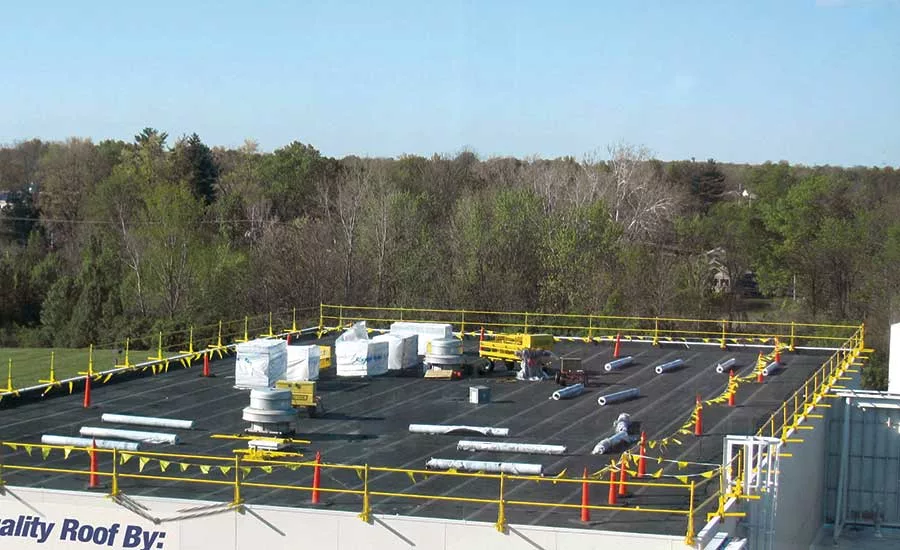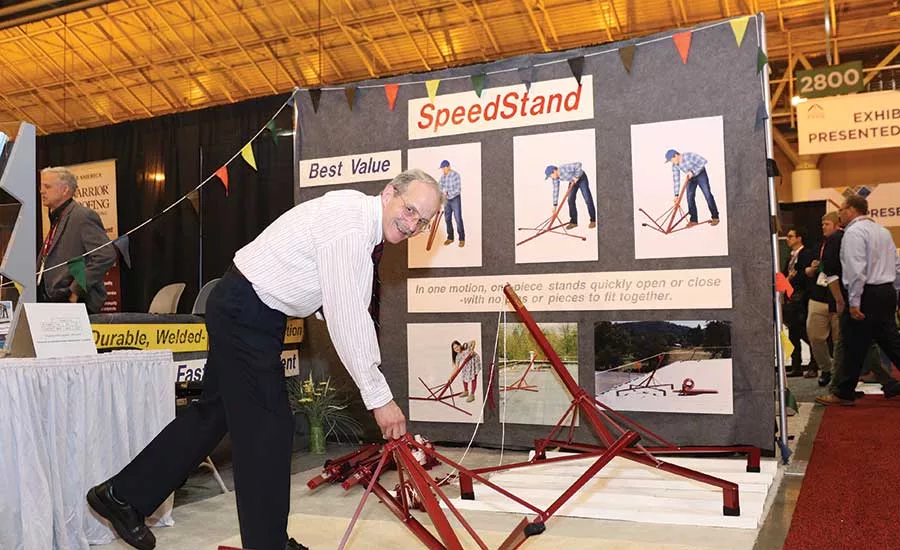The Benefits of Rooftop Warning Line Systems for Roofing Contractors
An efficient warning line system reduces labor, gives the crew a quicker start, and is an integral part of the job.

Efficient handling, a few tricks, and a smart game plan make an effective warning line that protects workers, reduces labor, and increases production.

Efficient handling, a few tricks, and a smart game plan make an effective warning line that protects workers, reduces labor, and increases production.
The federal government’s fall protection laws (29 CFR 1926.501-502) allow for several fall protection systems on roofs with slopes of 4:12 or less.
Rooftop warning line systems are the most common fall-protection systems in use due to their low cost, portability, and ability to adapt to most roof geometries. They enclose the perimeter of a work area with a line at about waist height, and operate on the principle that the line will warn workers when they are dangerously near the roof edges.
Warning line systems consist of a flagged line that fences off a work area. The line is fastened to a series of strands that are set up 6 to 10 feet from the roof edges. Work performed between the roof edges and the warning lines is done under the supervision of a safety monitor. The safety monitor alerts workers near the edge of danger and monitors their safety.
Efficient handling, a few tricks, and a smart game plan make an effective warning line that protects workers, reduces labor, and increases production.
Basic Requirements
A warning line system includes the perimeter line, access for men and material, and special details such as protection at a tear off chute or a hot pipe.
The perimeter line is set up at least 6 feet from the roof edge. If a worker operates equipment (such as a gravel buggy or a felt layer) toward an edge, the warning line must be at least 10 feet from that edge, giving an added measure of safety. The flagged line must hang between 34 inches (.9 meter) and 39 inches (1 meter) above the roof deck (although flagline heights for California and Washington state codes presently differ from federal codes).
Where loading exposes an unprotected edge, the edge can be protected with a removable warning line. The ladder area may be set up in the same way or consolidated with the loading area. If a liftbed truck is used to load the roof, warning lines may be run from the gates of the truck to the warning line perimeter. If the roof is loaded with a crane or forklift, a safety monitor must supervise workers between the warning line and the edge. If the roof is loaded with a rope and wheel on a ladder, the receivers should be tied off with properly anchored safety lines and harnesses.
A hot pipe may be set up to pump inside the work perimeter or it must be supported with an 8- foot long guardrail.
Stand Parameters
When buying warning line systems be sure they meet OSHA requirements. This will protect your workers and avoid costly fines. OSHA codes require that a warning line system resist a 16-pound outward horizontal force on each stand without tipping over. The intent is to have a system that resists tipping over during construction and in moderate wind. Regrettably, some stands fail to meet the standard. The overturning resistance of a warning line system can be easily measured with a spring scale and tape applied as described in the code.
The greatest cost of using a warning line system is the cost of labor to handle and set it up on each job. An economical system will have stands that handle easily, allow a generous spacing between stands, hold up to the construction environment, and require little maintenance.
Stands are typically hauled to the job, loaded on the roof, set up, later repositioned, knocked down, unloaded, and returned to the shop. Since each stand is handled about seven times, an easy-to-handle stand will speed up their use. Stands that need to be weighted down will be slower to use.
Stands that can be spaced further apart require fewer stands for a given perimeter and less labor. Stands spaced too far apart the line becomes unstable and hard to use. The spacing between stands is controlled by the weight of the stands, the width of the stand bases, and by the pull of the flagline in the direction of the line. Wide stands can be spaced farther apart, and narrow stands will be spaced nearer.
Stands should be durable to endure the rigors of construction, and require little maintenance. Because stands pick up roof debris that can mark finished roof membranes, they need to be cleaned, usually with a solvent. Stands with large surfaces that lay on the roof pick up more debris and require much more cleaning.
Types of Stands
The three main types of stands presently available are base plate, cross-stand, and folding stands.
Base plate stands are two-piece stands consisting of a square or rectangular base with a fitted vertical post. They are made in steel or rubber. Flat bases pick up roof debris that mark light colored membranes. Consequently several designs include spacers placed on the corners or edges to greatly reduce the area of the base in contact with roof.
Steel stands have a square plate and a fitted vertical pipe (Fig. 2). The stands weigh about 45 pounds each, and are simple and durable. They are relatively heavy, and bulky to transport.
Rubber stands have a rectangular pad with a center hole where a plastic post is inserted. These stands are inexpensive and weigh about 30 pounds. They don’t have spacers on their corners so they tend to pick up roof debris which needs to be removed regularly. The narrowness of the rectangular pad reduces how far apart the stands can be spaced, requiring more stands to cover a given perimeter. Two pads are stacked on top of each other at the corners of the perimeter to meet the overturning resistance for the two edges at the corners. Some stands have small bases and must be dead weighted to meet the OSHA requirements for horizontal overturning resistance.
Cross-stands have a base made of two long bars crossed with a pivot at their center. A vertical post is fastened at the pivot with a removable pin. The post can be removed, the bars pivoted together, and the post fastened to the bars, making a compact rectangular package. The stands weigh about 37 pounds, stack compactly, and include a convenient carrying handle. They are slow to assemble and disassemble in the field, are subject to missing pins, and the post joint tends to become wobbly, making it hard to maintain the required warning line height.
Folding stands consist of a post with four collapsible and reinforced legs. These one-piece stands weigh about 24 pounds, set up and knock down quickly, and have a tilted post that keeps the base of the stand out of the work area. They’re more expensive, don’t lock in the folded position, and must be stored horizontally.
Warning Lines
Warning lines are made of rope with flags fastened every six feet. They are required to have a 500-pound tensile strength.
An inexpensive warning line is available with plastic pennants that is much like a car lot banner. They last about one month in the sun and are considered disposable. Most pennant warning lines are hand coiled and take some practice to avoid tangled line.
A polyester warning line flagged with yarns is available that can be coiled on a reel, avoids tangles line, and makes the job of setting up and removing the warning line a quick process. Polyester rope is a durable line with excellent sun and weather resistance that can be expected to last many years.
Efficient Handling
Handling stands on pallets and with insulation carts greatly reduces labor. A pallet of stands can be forklifted onto an insulation cart and the cart can be forklifted onto the truck. The carts can be hoisted onto the roof at the job site. If a lift bed truck is used to load the roof, the carts can be rolled down a ramp onto the roof.
Once on the roof, carts can easily distribute the stands around the perimeter. When roofing construction is finished, the truck is loaded with equipment and debris and lastly the carts are used to collect the stands and transport them for removal.
Moving a line of stands to work on an edge is made easier by coiling an extra eight feet of line on the corner stands. The extra line provides slack so that each stand can be moved to its new position without untying each stand. To add extra line to a corner stand, first tie the line to the corner stand, coil an extra eight feet of warning line, retie the line, then set the coil on the post.
An efficient warning line system reduces labor, gives the crew a quicker start, and becomes an integral part of the job. As a roofing crew masters the use of a warning line system, they focus more on building the roof and fall protection takes its natural role of providing safety.
Looking for a reprint of this article?
From high-res PDFs to custom plaques, order your copy today!


